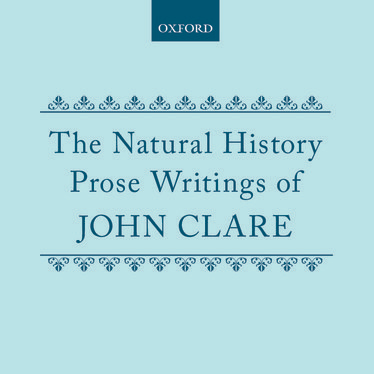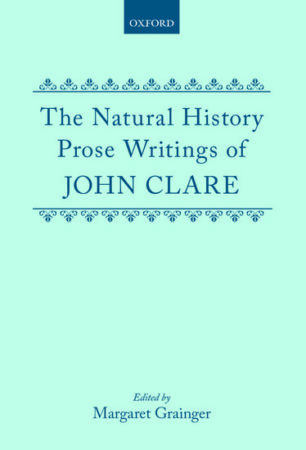John Clare

John Clare, The Natural History Prose Writings of John Clare, ed. by Margaret Grainger (Oxford: Clarendon Press, 1983)
John Clare, John Clare by Himself, ed. by Eric Robinson and David Powell (Manchester: Carcanet, 2002)
Recommended by Bethan Roberts
 With a couple of exceptions, Clare spent the first thirty-nine years of his life in one place: Helpston, ‘a gloomy village in Northamptonshire, on the brink of the Lincolnshire fens’, as he writes in his ‘Sketches of the Life of John Clare’ (John Clare by Himself), a ‘slip between two shores’, a place ‘not poetical enough’ for turtle doves as he describes it elsewhere (Natural History Prose). Sometimes, I’m not entirely convinced that Clare loved his native place for its own placeness. What the prose brings home to me is the particularity of Clare’s places: he’s a lover of ‘spots’ and ‘nooks’, this particular tree, these birds of this wood. The place names and place-specific natural history details of his prose are familiar from his poems – Swordy Well, Royce Wood, Langley Bush, nightingales, ferns, shells and orchids – and moments in the prose often recall those of his poems. As well as revealing further his skill as a fieldwork naturalist (his incomplete ‘Natural History of Helpstone’ written on the model of Gilbert White), the prose extends our insight into Clare’s poetic life: how he came to poetry and what poems he read, how and where he came to write his own, and what he also refers to as his ‘poetical’ feeling (the autobiographical fragment ‘Leisure’ is a particular treat in this regard), embedded in place and bound up with what Clare invariably describes as ‘love’.
With a couple of exceptions, Clare spent the first thirty-nine years of his life in one place: Helpston, ‘a gloomy village in Northamptonshire, on the brink of the Lincolnshire fens’, as he writes in his ‘Sketches of the Life of John Clare’ (John Clare by Himself), a ‘slip between two shores’, a place ‘not poetical enough’ for turtle doves as he describes it elsewhere (Natural History Prose). Sometimes, I’m not entirely convinced that Clare loved his native place for its own placeness. What the prose brings home to me is the particularity of Clare’s places: he’s a lover of ‘spots’ and ‘nooks’, this particular tree, these birds of this wood. The place names and place-specific natural history details of his prose are familiar from his poems – Swordy Well, Royce Wood, Langley Bush, nightingales, ferns, shells and orchids – and moments in the prose often recall those of his poems. As well as revealing further his skill as a fieldwork naturalist (his incomplete ‘Natural History of Helpstone’ written on the model of Gilbert White), the prose extends our insight into Clare’s poetic life: how he came to poetry and what poems he read, how and where he came to write his own, and what he also refers to as his ‘poetical’ feeling (the autobiographical fragment ‘Leisure’ is a particular treat in this regard), embedded in place and bound up with what Clare invariably describes as ‘love’.